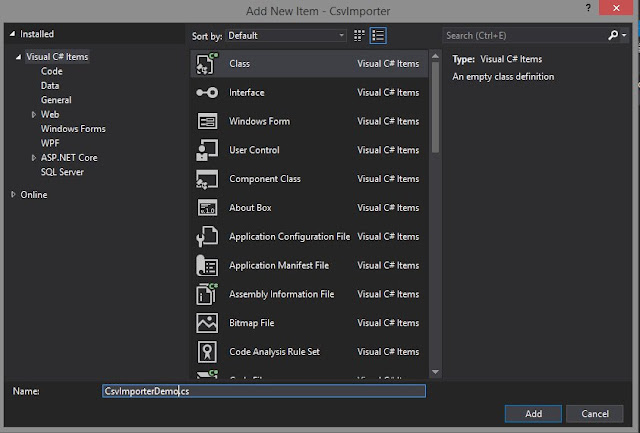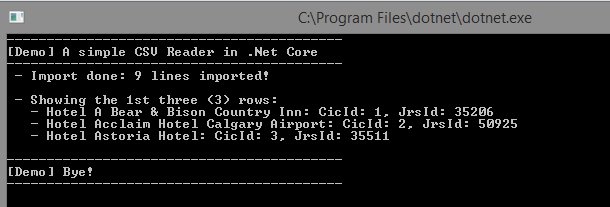Accessing CSV is a common tasks in development. Let's review a simple yet elegant solution on how to do it using C#.
One common requirement is to deal with external files, especially CSV files. Because in theory CSV files are simple, developers tend to rush and implement their own parsers. However, it takes a lot of work (and uncountable bugs) to write a good CSV reader/writer. The effort is simply not worth it: you shouldn't repeat yourself. Luckly, Josh Close has built the excellent CSVHelper for us. Let's test it out.Importing CSV files with C#
Let's review then a very simple use case to demo how can we import CSVs, parse them to a strongly typed model using CSVHelper. For this demo, I will be using Visual Studio 2017 and the following CSV file:
Step 1: Create a new .NET Core project
So, go and create a new project:
Step 2: Reference the CsvHelper Nupkg to your solution
Next, add a nuget reference to the CsvHelper nupkg to your project and accept the terms.
Step 3: Add the CsvLine model class
Now with my project referencing the CsvHelper package, I still need two more classes. The first one,
I called it CsvLine. This class represents each of the imported records in the csv, apart from the header.
This class name is very anemic. In a production code I wouldn't name it if I needed to use that class elsewhere but for this post, it helps simplifying the explanation.
The code for this class looks like:
Step 4: Add the CsvImportedDemo class
Next, add a class to your project (Project -> Add -> New Item) [or just Alt-Shift-C when selecting your project in Visual Studio's Solution explorer] called CsvImporterDemo. This class will act as the facade of my project containing the logic to orchestrate the execution flow.
CsvImporterDemo will contain a Import method that basically will:
- open the file;
- feed csv reader;
- load all recs on the file with the csv reader;
- print some of the records
The code for this class looks like:
Debugging the .NET Core console app
Because I plan to specify the imported file from the command line, I need to provide args to my project before running. This is done on project properties window -> Debug -> add "Application arguments". Ex:
So that when I run my code in debug mode, I get the params that the user is supposed to pass in the command line:
All set! Now, before we run it and see the results, let's add a nice tip.
Tip: Override ToString and use string interpolation
A nice caveat to add for this extremely simple project is to override the ToString method on the CsvLine class. This allows us to format its return when calling the ToString method. A bonus here is to use string interpolation to simplify even more our logic:
Running on Windows
Now, let's run it. From within Visual Studio, just pressing F5 runs in debug mode for me. Here's the output in windows:
We also can run it directly from the terminal (but don't forget to pass the filename) with:
dotnet CsvImporter.dll --file export.csv
Conclusion
We showed some interesting things on this demo:
- how to import CSV files the simple way. For more complex scenarios, check this link;
- publishing .NET Core apps;
- some programming techniques such as string interpolation, method overrides, programming concepts and some design patterns were introduced;
- how to run .NET Core apps from the console;
- run to run run a .NET Core app in Linux.
Source Code
As always, the source for this project on my GitHub.
See Also
- My journey to 1 million articles read
- Adding Application Insights to your ASP.NET Core website
- Creating ASP.NET Core websites with Docker
- Send emails from ASP.NET Core websites using SendGrid and Azure
- Configuration in .NET Core console applications
- Distributed caching in ASP.NET Core using Redis, MongoDB and Docker
- Hosting NuGet packages on GitHub
- How to create a Ubuntu Desktop on Azure
- Windows Subsystem for Linux, the best way to learn Linux on Windows
- Simplifying Razor logic with C# Local Functions in ASP.NET Core
- Building and Running ASP.NET Core apps on Linux
- Generating views in the backend with ASP.NET and ASP.NET Core









